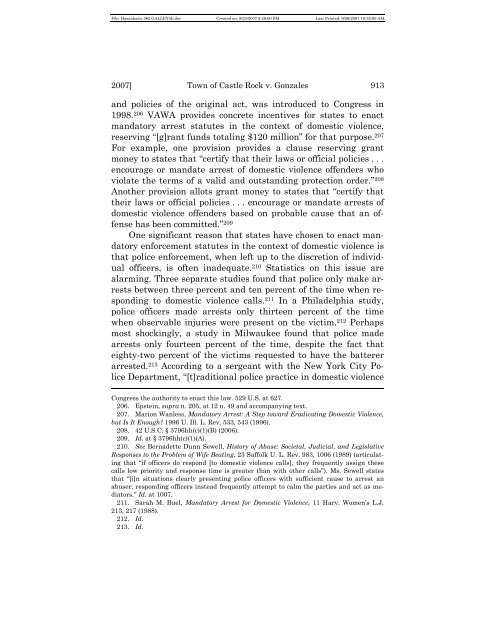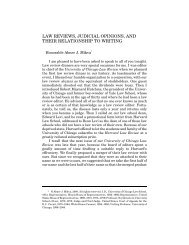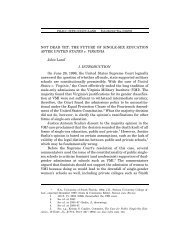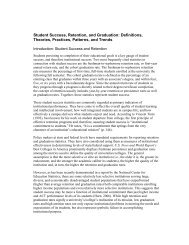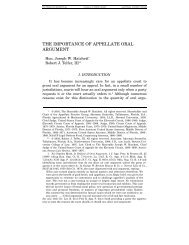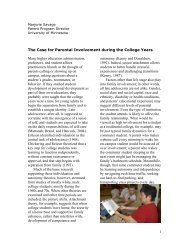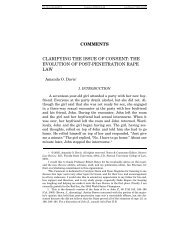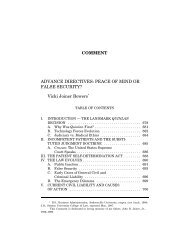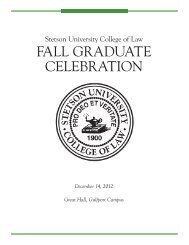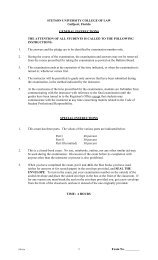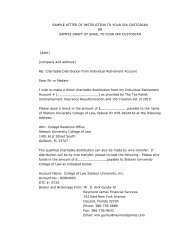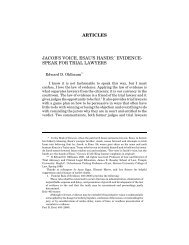TOWN OF CASTLE ROCK v. GONZALES: THE ... - Stetson University
TOWN OF CASTLE ROCK v. GONZALES: THE ... - Stetson University
TOWN OF CASTLE ROCK v. GONZALES: THE ... - Stetson University
You also want an ePaper? Increase the reach of your titles
YUMPU automatically turns print PDFs into web optimized ePapers that Google loves.
File: Hasanbasic.362.GALLEY(d).doc Created on: 9/25/2007 2:29:00 PM Last Printed: 9/26/2007 10:35:00 AM2007] Town of Castle Rock v. Gonzales 913and policies of the original act, was introduced to Congress in1998. 206 VAWA provides concrete incentives for states to enactmandatory arrest statutes in the context of domestic violence,reserving “[g]rant funds totaling $120 million” for that purpose. 207For example, one provision provides a clause reserving grantmoney to states that “certify that their laws or official policies . . .encourage or mandate arrest of domestic violence offenders whoviolate the terms of a valid and outstanding protection order.” 208Another provision allots grant money to states that “certify thattheir laws or official policies . . . encourage or mandate arrests ofdomestic violence offenders based on probable cause that an offensehas been committed.” 209One significant reason that states have chosen to enact mandatoryenforcement statutes in the context of domestic violence isthat police enforcement, when left up to the discretion of individualofficers, is often inadequate. 210 Statistics on this issue arealarming. Three separate studies found that police only make arrestsbetween three percent and ten percent of the time when respondingto domestic violence calls. 211 In a Philadelphia study,police officers made arrests only thirteen percent of the timewhen observable injuries were present on the victim. 212 Perhapsmost shockingly, a study in Milwaukee found that police madearrests only fourteen percent of the time, despite the fact thateighty-two percent of the victims requested to have the battererarrested. 213 According to a sergeant with the New York City PoliceDepartment, “[t]raditional police practice in domestic violenceCongress the authority to enact this law. 529 U.S. at 627.206. Epstein, supra n. 205, at 12 n. 49 and accompanying text.207. Marion Wanless, Mandatory Arrest: A Step toward Eradicating Domestic Violence,but Is It Enough? 1996 U. Ill. L. Rev. 533, 543 (1996).208. 42 U.S.C. § 3796hh(c)(1)(B) (2006).209. Id. at § 3796hh(c)(1)(A).210. See Bernadette Dunn Sewell, History of Abuse: Societal, Judicial, and LegislativeResponses to the Problem of Wife Beating, 23 Suffolk U. L. Rev. 983, 1006 (1989) (articulatingthat “if officers do respond [to domestic violence calls], they frequently assign thesecalls low priority and response time is greater than with other calls”). Ms. Sewell statesthat “[i]n situations clearly presenting police officers with sufficient cause to arrest anabuser, responding officers instead frequently attempt to calm the parties and act as mediators.”Id. at 1007.211. Sarah M. Buel, Mandatory Arrest for Domestic Violence, 11 Harv. Women’s L.J.213, 217 (1988).212. Id.213. Id.


